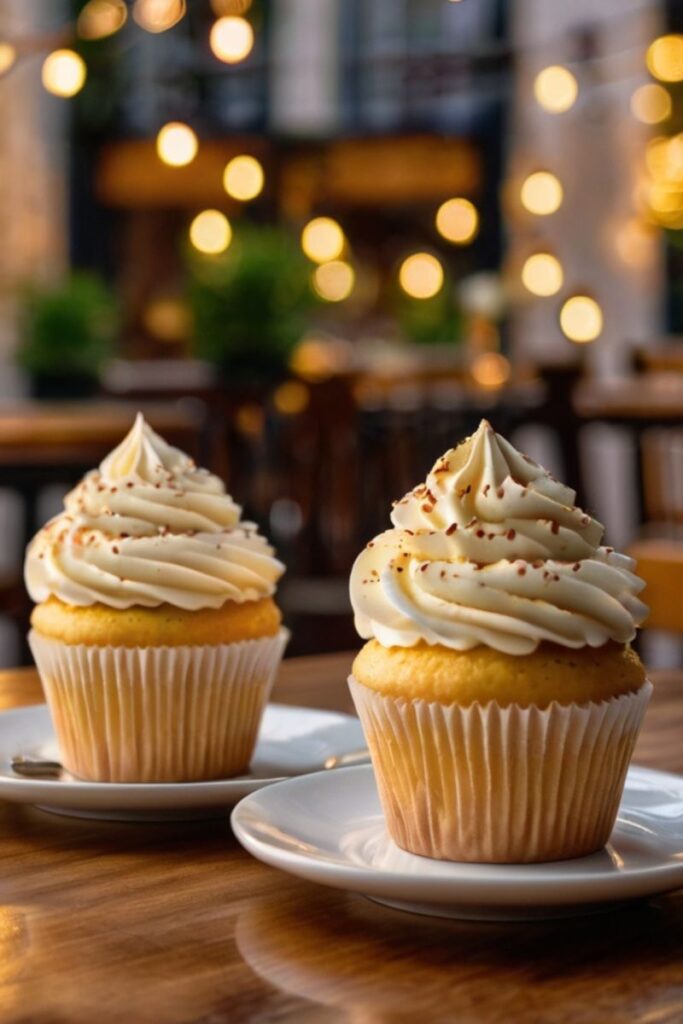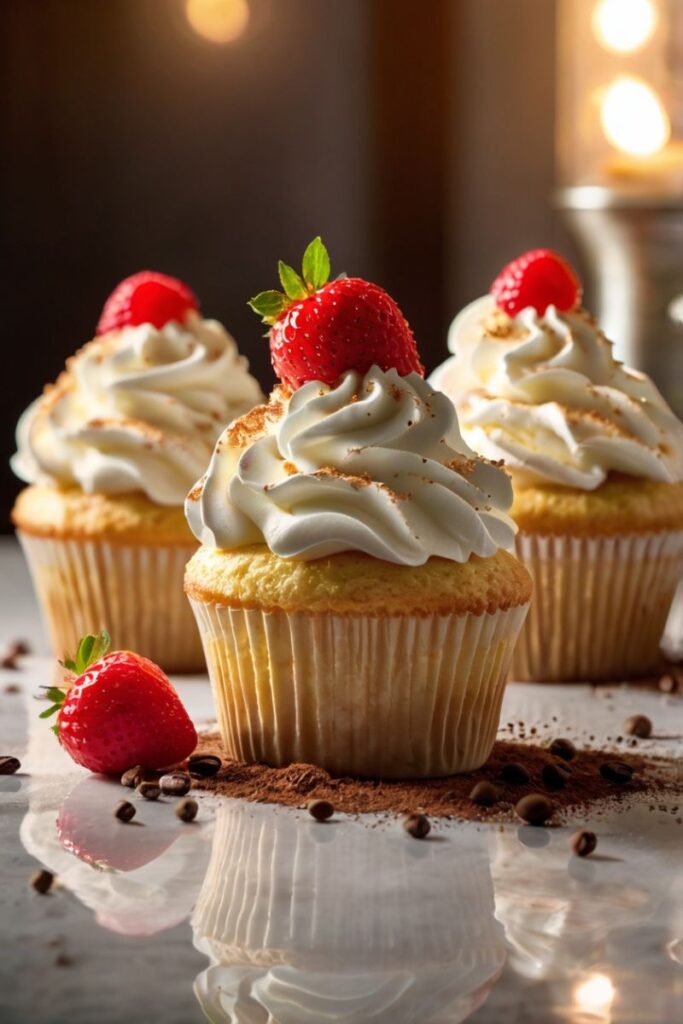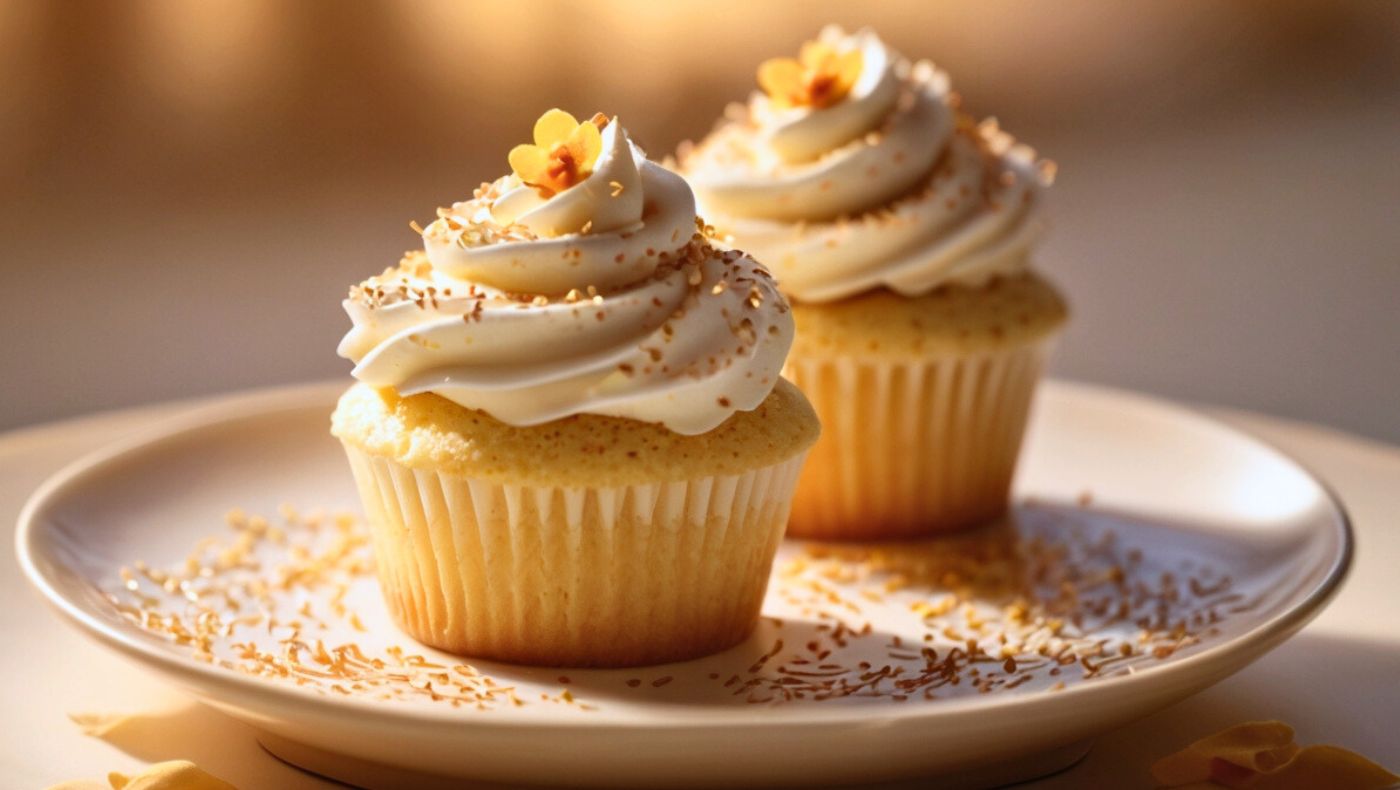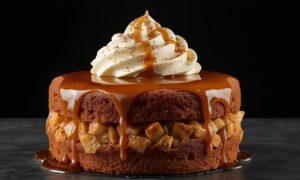“Can a cupcake be rich, moist, and still feel light as air?” The answer is yes if it’s a Tres Leches Cupcake. I was at a summer family gathering the first time I had one. My aunt brought out a tray of cupcakes that looked simple at first glance, but one bite changed everything. The cake was incredibly soft, soaked with a sweet blend of three milks: evaporated milk, condensed milk, and heavy cream. It was cool, creamy, and melt in your mouth delicious. Topped with a swirl of whipped cream and a light dusting of cinnamon, it tasted like a celebration in every bite.
These Tres Leches Cupcakes are inspired by the beloved Latin American tres leches cake, a dessert known for its rich flavor and tender texture. But in cupcake form, they’re easier to serve, share, and enjoy anytime. They bring all the decadence of the original cake into a personal, portable treat.
In this guide, I’ll walk you through each step of making Tres Leches Cupcakes from baking the perfect sponge to mastering the milk soak, and topping them with just the right amount of whipped cream. You’ll also learn professional tips for getting that perfect balance of moisture without making them soggy. Whether you’re new to baking or looking for a crowd pleasing dessert with cultural flair, this recipe is one you’ll want to make again and again.
1. Ingredients & Substitutions
For the Cupcakes:
- 1½ cups (180g) cake flour (not self rising)
- 1½ teaspoons baking powder
- ¼ teaspoon salt
- ½ cup (113g) unsalted butter, room temperature
- 1 cup (200g) granulated sugar
- 5 large eggs, separated
- 1½ teaspoons vanilla extract or vanilla bean paste
- ½ cup (120ml) whole milk
- ¼ teaspoon cream of tartar
For the Tres Leches Soak:
- 1 can (14oz/397g) sweetened condensed milk
- 1 can (12oz/354ml) evaporated milk
- ½ cup (120ml) heavy cream
- 1 tablespoon rum (optional)
- 1 teaspoon vanilla extract
For the Whipped Cream Topping:
- 2 cups (480ml) heavy whipping cream, cold
- ⅓ cup (40g) powdered sugar
- 1½ teaspoons vanilla extract
- 2 teaspoons unflavored gelatin
- 2 tablespoons cold water
- Ground cinnamon for dusting
- Fresh berries or maraschino cherries for garnish (optional)
Cake flour is crucial here its lower protein content creates the tender crumb we need to absorb liquid without collapsing. If unavailable, substitute with all purpose flour mixed with cornstarch (for every cup of all purpose flour, remove 2 tablespoons and replace with 2 tablespoons cornstarch). The protein structure makes ALL the difference in the final product.
For dairy free alternatives, coconut milk can replace evaporated milk, coconut cream can substitute for condensed milk (with added sweetener), and full fat coconut milk works for heavy cream. These swaps change the flavor profile, embracing more tropical notes but maintain the essential moisture that defines tres leches.
Vanilla bean paste offers more pronounced vanilla flavor than extract, with those gorgeous specks throughout. Worth the splurge if making these for a special occassion or clients.
2. Step by Step Instructions

Preparing the Cupcakes:
- Preheat your oven to 325°F (163°C) and line two 12 cup muffin tins with cupcake liners. I recommend doubling up the liners or using high quality ones since these will get very moist.
- Whisk together the cake flour, baking powder, and salt in a medium bowl. Set aside. The proper incorporation of dry ingredients now prevents troubleshooting texture issues later.
- In the bowl of a stand mixer fitted with the paddle attachment, cream the butter and sugar on medium high speed until pale and fluffy, about 3-4 minutes. Don’t rush this step; proper aeration here creates the structure that’ll later support all that moisture.
- Add the egg yolks one at a time, beating well after each addition. Mix in the vanilla extract. The mixture might look slightly curdled; that’s perfectly normal at this stage.
- With the mixer on low, add the flour mixture in three additions, alternating with the milk, beginning and ending with the flour. Mix just until combined, scraping down the sides as needed. Over mixing activates gluten and will result in tough cupcakes.
- In a clean mixer bowl with the whisk attachment, beat the egg whites with cream of tartar until stiff, glossy peaks form. This is where the lift in our cakes comes from.
- Gently fold the beaten egg whites into the batter in three additions. Use a large spatula and employ a ‘J fold’ technique cut through the center and sweep up from the bottom. You’re aiming to preserve as much air as possible.
- Fill each cupcake liner about ⅔ full. These will rise significantly but then shrink slightly after baking exactly what we want.
- Bake for 18-20 minutes, or until a toothpick inserted in the center comes out clean and the tops spring back when lightly pressed. The cupcakes should be pale golden, not brown.
- Cool in the pans for 10 minutes, then transfer to wire racks to cool completely. While cooling, prepare your milk mixture.
Making the Tres Leches Soak:
- In a medium bowl, whisk together the condensed milk, evaporated milk, heavy cream, optional rum, and vanilla until well combined. The mixture should be smooth and homogenous.
- Once cupcakes are completely cool, use a fork to poke several holes in the top of each cupcake. Don’t be shy here more holes mean better milk absorption.
- Place cupcakes on a rimmed baking sheet with some space between them. Slowly spoon about 1½-2 tablespoons of the milk mixture over each cupcake, allowing it to absorb. Wait a minute, then add more until you’ve used roughly 3 tablespoons per cupcake.
- Cover loosely with plastic wrap and refrigerate for at least 2 hours, preferably overnight. The resting period is non negotiable it allows for proper distribution of moisture throughout the sponge.
Preparing the Stabilized Whipped Cream:
- In a small microwave safe bowl, sprinkle the gelatin over cold water and let stand for 5 minutes to bloom. This step is essental for proper gelatin hydration.
- Microwave the gelatin mixture for 5-10 seconds until just melted. Let cool slightly but don’t allow it to set.
- In a chilled mixer bowl, combine the heavy cream, powdered sugar, and vanilla. Begin whipping on medium speed.
- When the cream starts to thicken, slowly pour in the gelatin mixture while continuing to beat. Increase speed to medium high and whip until stiff peaks form. Timing is everything here add the gelatin too soon, and it won’t incorporate properly; too late and you risk overbeating.
- Transfer the whipped cream to a piping bag fitted with a large star tip. Pipe decorative swirls onto each cupcake. A swift, confident hand creates the most professional finish.
- Dust lightly with ground cinnamon and garnish with fresh berries or maraschino cherries if desired.
3. Cooking Techniques & Science
The science behind tres leches cupcakes is fascinating and involves several key principles. First, the structure of the cake must be precisely engineered, sturdy enough to withstand soaking but with sufficient air pockets to absorb liquid. This is why we use separated eggs and fold in beaten whites; they create a network of tiny air cells.
The protein structure of cake flour (with its lower gluten content) forms a more delicate web than all purpose flour would. When the milk mixture is added, this web gets saturated but maintains integrity. If you’ve ever had a tres leches cake that’s soggy rather than moist, the baker likely used too much liquid or had a poorly structured crumb.
Temperature control is critical throughout the process. Room temperature ingredients ensure proper emulsification in the batter. When soaking, cold milk mixture and room temperature cupcakes create an optimal absorption rate. The stabilized whipped cream requires chilled equipment and ingredients to achieve proper volume.
The gelatin stabilization technique for the whipped cream is essential for professional quality results. Without it, the cream would weep and deflate within hours a disaster for advance preparation or commercial settings. The gelatin forms a molecular network that traps water and fat molecules, maintaining the cream’s structure.
The slight acidification from cream of tartar helps stabilize the egg whites by preventing protein molecules from bonding too tightly. This creates a more stable foam with greater volume, essential for the light texture we’re aiming to achieve.
4. Serving & Pairing Suggestions

Tres leches cupcakes shine brightest when served properly chilled, removed from the refrigerator about 15 minutes before serving to take the edge off the cold. The contrast between the cool, moist cake and the soft whipped cream topping is part of the experience.
For plating in a professional setting, consider a small pool of additional tres leches mixture on the plate with the cupcake centered on top. A light dusting of cinnamon creates visual warmth, while a precisely placed fresh berry or edible flower adds a pop of color against the white canvas.
Coffee pairings are traditional and effective the bitterness cuts through the sweetness beautifully. A cortado or café con leche makes a particularly harmonious match. For more adventurous pairings, consider an aged rum or even a dulce de leche liqueur.
These cupcakes work superbly in a dessert flight alongside contrasting textures like crisp churros or a small scoop of mango sorbet. In catering situations, they can be prepared up to 36 hours in advance and hold remarkably well, making them ideal for large scale events.
For a deconstructed presentation, consider placing torn pieces of soaked cake in a glass, layered with the whipped cream and finished with fresh fruit compote a modern interpretation that preserves all the flavors while offering a unique textural experience.
Final Thoughts: Tres Leches Cupcakes
Tres Leches Cupcakes represent the perfect intersection of technique, science, and cultural heritage. The success of these delicate treats hinges on understanding the structural requirements of the cake, the absorption principles of the soaking process, and the stabilization techniques for the topping.
What makes these Tres Leches Cupcakes truly special is their transformative nature—a relatively simple vanilla cake becomes something extraordinary through the soaking process. Master this technique, and you’ve added not just a recipe but a fundamental method to your professional repertoire.
When troubleshooting, remember that most issues stem from structural problems in the cake itself or improper soaking technique. Too much liquid too quickly will create soggy spots; too little will result in dry patches. Balance and patience are your allies.
For creative variations, consider infusing the milk mixture with spices like cardamom or saffron, or introducing citrus zests into the cake batter. The basic template is infinitely adaptable once you understand the core principles.
Frequently Asked Questions
Q: Why did my cupcakes shrink after baking?
A: This shrinkage is actually ideal for Tres Leches Cupcakes as it creates the perfect vessel for absorption. If they don’t shrink slightly, they might be too dense to properly soak up the milk mixture.
Q: Can I make these cupcakes ahead of time?
A: Yes! They improve with an overnight rest and will hold beautifully for up to 3 days refrigerated. Add the stabilized whipped cream no more than 24 hours before serving.
Q: How do I prevent milk pooling in the liners?
A: Add the milk mixture in smaller increments, allowing 30–60 seconds between additions. Also ensure your cake has the right structure—not too dense.
Q: Can I freeze Tres Leches Cupcakes?
A: You can freeze the unfrosted, unsoaked cupcakes, but completed Tres Leches Cupcakes don’t freeze well due to their high moisture content.
Q: What’s the best way to serve Tres Leches Cupcakes?
A: Serve them chilled with a swirl of stabilized whipped cream and a dusting of cinnamon or fresh fruit on top. Use foil liners or cupcake cups to hold the moisture.
Q: Why is my cake too soggy or falling apart?
A: Too much milk or an overly delicate cake base can cause this. Stick to the recommended soak amount and allow proper chill time to firm up the structure.
Q: Can I use store bought whipped topping instead of homemade?
A: Yes, but homemade stabilized whipped cream gives a fresher taste and better texture, especially if you’re serving to guests or at events..

Swiftly Captions by Tina Smith — Quick, flavorful food recipes made simple, bringing fresh inspiration to your kitchen every day






